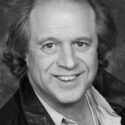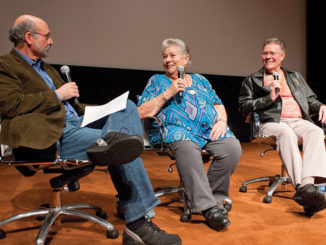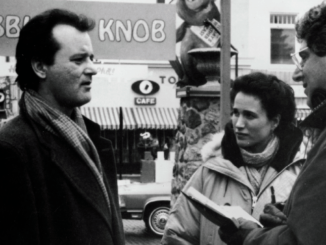
by Michael Kunkes
It was all an elaborate conspiracy, plotted down to the most minute detail among like-minded mixers and sound and picture editors. This was the only way, it was reasoned, that the detailed, highly emotional soundtrack for MGM and the Weinstein Company’s Bobby, about the day Robert F. Kennedy (RFK) was killed at LA’s Ambassador Hotel, could be carved out of a budget that belied the importance of writer/director Emilio Estevez’s dream project that was a decade in the making.
Recreating the sounds of June 5, 1968—from the smallest period flavors such as teletypes, electric fans and tinny TV speakers, to the vast and chaotic soundscape of those final minutes in the Ambassador’s ballroom and pantry—became a balancing act, a collision between funding and passion that somehow all ended up working together in total harmony.
Oscar-winning film editor Richard Chew, ASC, who was working at Todd-AO West on the picture side of the project since the first day of shooting, was joined by re-recording mixer Mike Minkler, CAS, a two-time Oscar winner for Chicago and Black Hawk Down, and a British Academy of Film and Television Arts (BAFTA) winner, interestingly enough, for his work on Oliver Stone’s JFK. “I’ve known Emilio for many years and when I heard he was beginning post-production, I offered my support to him and Richard,” he recalls. “There wasn’t much money left in the budget for post, but this was a labor of love for Emilio and we all wanted to get it done any way we could.”
Minkler brought in Glenn T. Morgan, MPSE (Open Water, Live From Baghdad, Monsters Ball), as supervising sound editor, and fellow re-recording mixer Tony Lamberti (My Super Ex-Girlfriend, Sideways, Monster) as sound effects mixer. “I’ve had a lot of success working on what I call ‘financially challenged’ films, but only because I tend to be very selective in what those films are,” Morgan says. “I was honored to be working with talent like Mike, Richard and Tony.”
Work began in earnest on the sound for Bobby after a first temp dub was created in March of this year, shortly after principal photography wrapped. “We just saw wonderful potential there,” Minkler says. “Everyone came up with a lot of different ideas and we went back into the studio, made a real temp mix.”
“This is what a ‘60s film should sound like. If you were to play Bobby after The Graduate, which was kind of our template, you wouldn’t hear much difference in the soundtracks.” – Mike Minkler
The “financially challenged” nature of Bobby kept the use of locations, especially outdoor ones, to a minimum. Due to limited shooting time at the Ambassador, which was under partial demolition, the 1921-vintage, 500-room landmark was constructed from bits and pieces of Los Angeles locales—primarily Santa Anita Racetrack for the pantry, the Park Plaza Hotel for the lobby, Castle Green in Pasadena for the gardens, and a lot of stage work at Santa Clarita Sound Stages. The hotel itself became another big-name cast member.
ADR played a key role in Bobby’s commitment to authenticity, especially in the scenes involving the Latino kitchen help. Originally, there was no budget for the Latino voices, but Minkler, Morgan and Chew were insistent on getting that single day of group Walla. “The Spanish language in LA is a lot different today than it was 40 years ago; the colloquialisms were way different, as were the dialects,” says Morgan. “Also, the Latin population wasn’t as diverse then as it is today, where there are Dominicans, Argentineans, Peruvians, etc., and a lot more English mixed in with street slang.”
Morgan pre-cast and directed the loop group with the idea in mind of casting half the voices from an age group that experienced the 1960s, so they could impart their speech and knowledge of that era to the younger members of the troupe, which was wrangled by Caitlin McKenna. “Each of the kitchen help scenes are different,” says Morgan. “As the film opens, they are frantically preparing free breakfast for guests who have been put out by an early morning fire alarm. Then they are seen getting ready for lunch or for the ballroom activities. There was always a purpose whenever we went back into the kitchen.”
In another moment, Anthony Hopkins has just said goodnight to Harry Belafonte and is standing at the hotel entrance when RFK’s entourage suddenly arrives and blows past him. Says Chew, “I listened to it first without the group Walla and I was very specific in the way I asked Glenn to construct the sound, with this whoosh of attention and energy that blows by Hopkins and then leaves him standing there alone in a dramatic silence.
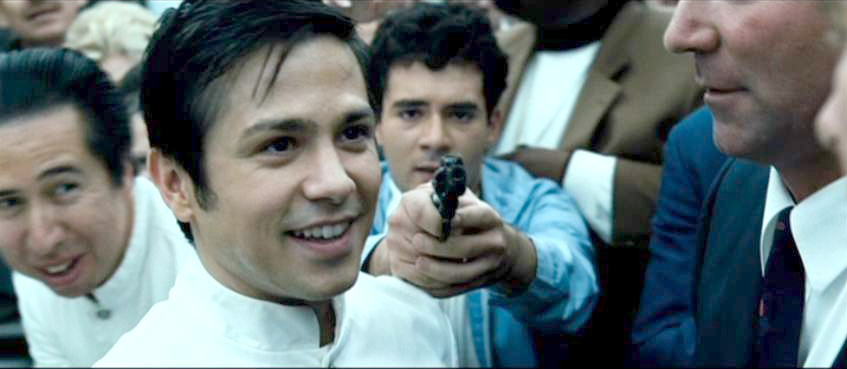
“Over a series of four different temp dubs, I was able to work with Glenn to hone in on what was working and what wasn’t,” Chew recalls. “In the scene in the hotel room where hotel manager Bill Macy and switchboard operator Heather Graham are breaking off their affair, I wanted the sound of a helicopter outside the hotel room window. I didn’t want it to be a sentimental scene; I wanted to provide the sense that something was not right. It worked much better than some non-specific exterior street sounds and made the scene much more stark.” “That scene was Richard’s homage to Apocalypse Now,” Morgan interjects, laughing.
The biggest challenge for the sound effects team was the sequence that covered roughly the last ten minutes of Bobby—from the time the crowds assemble in the ballroom through the assassination and end titles. The sequence was difficult to pull off because while the archival footage shows the size and density of the crowded room, the newly filmed sequences were shot largely in small, compressed spaces. “It was critical that we create a sonic density that would match that archival footage and make everything bigger,” says Morgan.
The team assembled every bit of archival sound they could get from June 5, from the ballroom, the speeches, the kitchen, the pantry, and the chaos outside the hotel. Morgan adds, “We had to work backwards from the archival recordings out, as opposed to integrating archival sound into what we had already did. It ended up becoming quite seamless.”
“Once we had all that sound, we had to work backwards, because we knew we were going to end up at that location at the end,” says Minkler. “So I knew I had to make a choice. I couldn’t go in and out of a sonic world that was archival into today’s world, because the archival material was so many generations away from the original. I had to take the production tracks and sonically treat them through a lot of older analog and tube equipment to degrade them to a point where they both meshed together (that equipment included a Teletronix LA-2A tube-leveling amplifier and a Urei 1176 compressor at 565 filter set). I had to make choices scene-by-scene how far to go with that. It was a matter of finding the proper moments before we decided what was most important to deal with.”
“I’ve had a lot of success working on what I call ‘financially challenged’ films, but only because I tend to be very selective in what those films are,” – Glenn T. Morgan
The archival news footage from that fateful day in late spring 1968 proved to be a goldmine for the audio as wellas the imagery. “Inside that footage was also the archival audio of Kennedy taking the podium while the crowd was chanting, ‘We want Kennedy,’ and ‘We want Bobby.’ Those chants are actually embedded in the recordings and are very powerful, moving and unbelievably eerie. There was magic in those tracks and we wanted to capture it,” acknowledges Morgan.
Again, ADR and the loop group were utilized. “We took the archival footage of the chants onto Mike’s stage, set up four mics and played the audio out over the speakers, recording it back into four tracks,” Morgan explains. “Then we brought the loop group in and put them behind the mics to do more chanting along with the original archival audio. Then we took that recording and overdubbed it.
“We were able to get a natural spread of chanting to get that density, and that’s how we were able to replicate the sound of that room and really get a sense of actually being there,” Morgan continues, adding that the entire process was recorded directly into ProTools. “Some people call that ‘world-izing,’ he says. “It was used quite a bit by the sound crew on Walk the Line as a way of recreating a sonic environment that no longer exists in reality.”
“More than any other show I can remember, this was a movie that was done in steps,” states Minkler. “Usually, you get a feel for what’s working or not working, acclimate to the show, block out time for each process and go. Bobby however, was an experiment from start to finish. Everything was shifting all the time—from the score to the songs to the sound effects.” And while everyone’s different ideas made things seem chaotic, the final result did not come about through compromise but from “pushing and pulling things as far as we dared to,” admits the mixer.
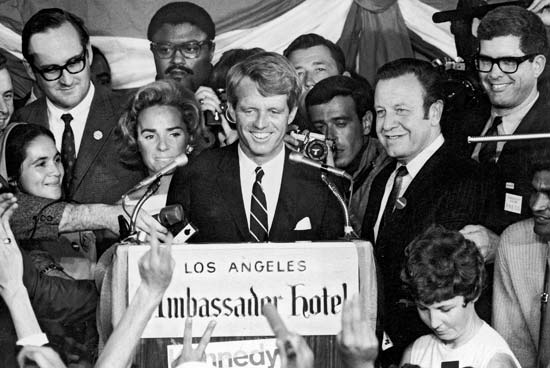
“We had a certain sound in mind and worked backwards, quickly trying out different ways to get it right—without a pre-conceived notion of how we could get there,
Minkler recalls. “If this were a movie that took place in 2006, I would have made it way slicker and more elegant with much higher artistic qualities. And if Bobby had been a big-budget studio film, there’s much more I would have re-done in ADR. But that was not this movie.
“We wanted it to have a harder, older quality and stay within the integrity of the period,” he continues. “This is what a ‘60s film should sound like. If you were to play Bobby after The Graduate, which was kind of our template, you wouldn’t hear much difference in the soundtracks.”
All told, there was a week devoted to the final mix, which was completed on a Euphonix System 5 console on Stage One at Todd-AO West. “There was almost no time for pre-dubs and spotting; you just had to pick your spots,” reveals Morgan. “But Mike plays the console like an instrument––always tweaking things and getting emotional about the project.” Lamberti adds, “When Mike mixes a show he has a very specific sound in mind. My editing experience allowed me to manipulate the raw tracks when needed to help support the track and help all the pieces fit.”
“To be economical means to be accurate,” says Minkler. “You can try a lot of different things, but only once. You have to have the experience to get it right the first time. Working on a low-budget feature requires more experience, not less. Personally, I don’t believe someone is a good mixer until they’ve done this for 10 or 15 years and has 50 films under the belt.”
What comes through in Bobby, from start to finish, is the trueness of all the performances and the passion that went into making it. “There was a collective feeling of love and support for Emilio and Richard by everyone who worked on it, ”Minkler concludes. “Because of those feelings, a lot of us went way beyond what we will normally will do.


